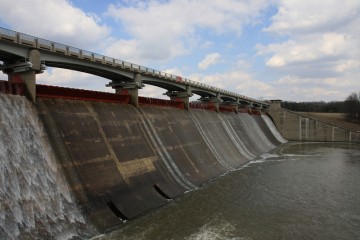
The Ohio Department of Natural Resources (ODNR) has showed its commitment to dam safety by establishing the Ohio Dam Safety Program, which allows businesses and residents to continue to use the state’s many lakes and reservoirs for business or recreation without sacrificing the safety of those downstream. Dam and reservoir failures can lead to countless injuries and deaths, millions of dollars in damage, and displacement of citizens, so it’s important that dam safety be a priority in Ohio.
Why is Dam Safety Important?
While modern dams are hugely beneficial to Ohio communities, they also pose potential safety hazards. Over the last century, high-profile dam and reservoir failures have devastated communities across the U.S., killing hundreds of people and displacing even more. Dam failures can occur in the blink of an eye, so it’s important for dam operators, safety officials, and community members to be prepared for such a disaster in their own communities. One way to prevent this devastation is to identify signs of failure before disaster strikes, allowing for time to evacuate citizens and, if possible, make necessary repairs to the structure.
What Causes Dam Failure?
There are three main concerns when it comes to dam failure. The first, accounting for about one-third of all dam failures in the U.S., is called overtopping. Overtopping often occurs when the spillway has been poorly designed or has been blocked by debris, causing structural damage or allowing water to crest over the top of the dam. Foundation defects contribute to another 30 percent of dam failures. These dams are often poorly designed and experience problems related to settling, slope instability, and other preventable issues. Another cause of dam failure is piping, which occurs when water slowly seeps through pipes, spillways, foundations, and other sections of the dam, causing internal erosion that weakens the structure. Piping issues account for about 20 percent of all dam failures in the U.S.
About the Program
The Dam Safety Program was established by ODNR to keep Ohio’s citizens safe while allowing residents and businesses to continue to reap the benefits of the state’s many dams. The program holds dam owners accountable for maintaining the condition of the dam and eliminating risks to civilians.
The program operates on a five-year schedule, with every dam or levee undergoing a thorough inspection during each five-year period. The ODNR has also partnered with the U.S. Environmental Protection Agency and the Ohio Environmental Protection Agency to provide similar inspections of coal ash impoundments across the state. Thanks to FEMA funding, the state has also implemented an Emergency Action Plan to educate the public on emergency procedures for dam-related disasters. Additionally, the program seeks to modify safety and structural requirements for construction of new dams and reservoirs, including offering discounted fees for dam owners in compliance with the new rules.
For more information about the ODNR Dam Safety Program, visit the ODNR Division of Water Resources online.
Photo Credit: Stephen Kruso





